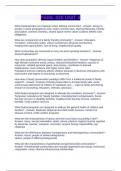FAML 430 UNIT 4
What characteristics are important when defining community? - Answer- Group of
people in same geographical area, under common laws, sharing fellowship, friendly
association, common interests, shared space norms values customs beliefs rules
obligations.
What are components of a family friendly community? - Answer- Education,
recreation, community safety, citizen involvement, physical environment,
employment opportunities, cost of living, neighborhood quality
Most communities are structured to carry out what reporting functions? - Answer-
Abuse/maltreatment?
How does population density impact children and families? - Answer- Negatives of
high density-excessive social contact, reduced behavioral freedom, scarcity of
resources, violated personal space, less privacy, contributes to learned
helplessness, more violence and higher crime rates
Population turnover indirectly affects children because it influences interactions with
newcomers and degree of community involvement
How does a family preservation paradigm differ from a traditional model of family
support? - Answer- Purpose of family preservation is to keep family safe, avoid
unnecessary placement of children in substitute care..., improve family functioning,
mixture of counseling, education, referrals, advocacy...
What federal programs are designed to alleviate the conditions of poverty? - Answer-
Temporary Assistance for Needy Families, Unemployment compensation, Social
Security survivor or disability benefits, Supplemental Security Income, Veteran's
benefits, Child nutrition services
What federal programs are designed to address the general health of children and
families? - Answer- Medicaid, Maternal and child health services, Centers for
Disease Control, Child nutrition programs
What are the characteristics of abuse and who must report according to law? -
Answer- Injury, sexual molestation, death, abuse, physical neglect must be reported
by physician, teacher, caregiver, counselor, anyone having responsibility over
child/care
What are the differences between homogeneous and heterogeneous communities? -
Answer- Homo: people of similar backgrounds
Hetero: people of differing backgrounds
What are the characteristics of gesellshaft and gemeinschaft communities? -
Answer- Gemeinschaft communities are mutually dependent and caring, communal,
cooperative, close, informal interpersonal relationships
, Gesellshaft communities are independent and contractual, practical, objective,
formal interpersonal relationships.
What are the characteristics and core objectives of the different type of community
services? - Answer- Public agencies: financed by taxation, administered within legal
framework of local/state/fed government, focus on preventing maltreatment of
children, protecting from abuse, providing permanent placement if home is unsafe
Private agencies: financed by donations/membership dues/ corporate
contributions/fees/etc, established by individuals/philanthropic/religious/humanitarian
groups, provide at-risk children and families with services in abuse prevention and
treatment, kinship care, juvenile justice, family foster care, adoption, positive youth
development, child day care, etc.
Combination agencies: use private and public sources of money, grants to
implement research, private donations for services beyond grant, wide range of
human and community development services and activities do decrease poverty and
help people in need
All three agency types can focus on Preventative (parks, rec, edu), Supportive
(family and child), or Rehabilitative (correction, mental health, special needs)
services
The health of children is most likely to be impacted at what point in their life? -
Answer- "The most important factors influencing child health occur before birth"
What is social control? How do communities use social control to enforce community
values and standards? - Answer- Rules/norms of a community... Small towns employ
social control by tradition, customs, fear of gossip or rejection. Large cities rely on
formal rules and regulations, formal sanctions.
The process of coming to know what is personally worthwhile or desirable in life at
any particular time is known as one? - Answer- Values clarification
What is the difference between an attitude and a value? - Answer- Value: qualities or
beliefs that are viewed as desirable or important
Attitude: tendency to respond positively or negatively to certain persons, objects, or
situations - composed of beliefs, feelings, and behavior tendencies
What is the difference between a stereotype and prejudice? - Answer- Prejudice:
prejudgment, application of previously formed judgement to some person, object,
situation
Stereotype: oversimplified, fixed attitude or set of beliefs that is held about members
of a group
What are common characteristics of children with the most prejudicial attitudes? -
Answer- Before 7, prejudicial attitudes are due to cognitive immaturity, not malice...
Parents more prejudicial
What experiences or opportunities are most likely to reduce prejudicial attitudes? -
Answer- Increased positive intercultural contact, vicarious intercultural contact,
perceptual differentiation




